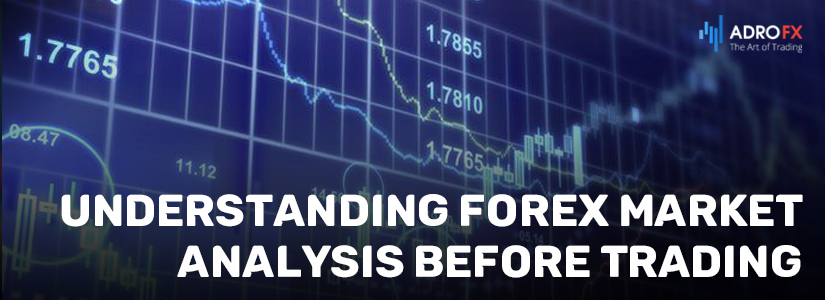Understanding Forex Market Analysis Before Trading

To grasp the intricate world of forex market analysis, it's imperative to recognize that the market is fundamentally driven by just two forces: supply and demand. These omnipresent factors serve as the underpinning for virtually every economic, political, social, and market event. The ebb and flow of supply and demand have a profound impact on the decisions of both bullish and bearish traders, influencing their open positions.
In this article, we will delve into the diverse techniques, styles, approaches, and strategies employed in forex market analysis. Intriguingly, all these methods share a common thread: they endeavor to gauge the dynamic forces of supply and demand. While some of these techniques may exhibit high accuracy, they often lag behind market prices. On the other hand, economic theories utilized in fundamental forex analysis may not offer pinpoint precision.
Traders have the unique ability to sway market sentiment, shifting from bullish to bearish and back again as they open and close positions. This, in essence, means that traders play a pivotal role in shaping the market they seek to analyze. To excel as a trader, it is crucial to grasp that gaining a competitive edge hinges on your adept understanding of supply and demand in forex analysis.

Forex Technical Analysis: Unveiling the Tools
A defining characteristic of technical forex market analysis is its reliance on charts. Any examination of charts for insights falls under the realm of technical FX analysis. Charles Dow, a prominent figure in the field, laid the foundation for chart analysis with his Dow Theory. Among his core assertions was that the market incorporates all available information. In simpler terms, Dow proposed that any factor influencing supply and demand will inevitably manifest in market prices, which are graphically represented in real-time on price charts.
Pure technical analysis emphasizes a focus on studying the price chart itself while considering almost everything beyond it as unquantifiable and unreliable data. However, it's important to recognize that this reliance on historical data is also a limitation of technical analysis, as it primarily examines what the market has already acknowledged. This begs the question for traders: how can one maintain a competitive edge when trading on widely known information?
Deciphering Price Action
Price action, a niche within technical forex analysis, has gained popularity since forex trading became accessible to the masses. Its rise to prominence is attributed to the belief that while it aligns with Charles Dow's theory, it deems most tools used by technical traders, such as traditional technical indicators, ineffective in providing a competitive edge.
Price action adherents conclude "naked" charts, using price movements as the foundation for their trading decisions. All other factors, if considered at all, serve merely to support these decisions and not to trigger them. The core tenet of price action analysis rests on the observation that the market often revisits price levels where it previously reversed or consolidated due to lingering supply or demand.
Understanding Remnant Supply and Demand
Institutional traders, representing banks, hedge funds, and multinational corporations, are primarily concerned with having their orders executed at their desired prices. Their forex analysis centers on the market's future direction, often months or even years ahead. If the market moves away from a level they traded today, they do not cancel their orders; instead, they maintain their positions until the market returns.
These outstanding orders left by institutional traders influence market dynamics, drawing prices back to those levels. This concept is akin to how mass warps the fabric of time and space, attracting more mass. Price action strategies are commonly used in daily forex analysis.
Unveiling the Power of Charting
Charts are the visual representation of a series of price quotes, providing a historical record of market activity. On the y-axis, you find the price, while the x-axis represents time. What is displayed on the chart is the price action itself. Regardless of one's trading style—be it long-term positional or short-term intraday—everything commences with charting.
Charting, interestingly, is a relatively recent addition to Western financial markets. Wall Street adopted the use of charts just over a century ago, though in the Far East, documents containing price quotes in the form of candlesticks date back over 300 years, known as "rice price quotes."
Candlesticks serve as the most fundamental tool for technical traders. Developing trading strategies based on raw candlestick patterns is a strategy in itself. In addition to recognizing common patterns, it is paramount to comprehend the underlying supply and demand forces shaping these patterns. Alongside bare candlesticks, technical traders may employ charting patterns, such as support and resistance lines, trend channels, triangles, and flags, among others. It's crucial to remember that these supporting structures do not predict future market movements; they serve as tools for traders to better understand past price actions. The same chart can appear to present various patterns to different traders or even to the same trader at different times, resulting in conflicting signals. This underscores the importance of not solely relying on these supporting structures for decision-making, but rather, considering the pivotal role of supply and demand in forex analysis.

Technical Indicators
When you delve into the realm of forex trading, technical indicators become an integral part of your toolkit. To provide clarity, we can categorize them into two broad groups: trend indicators and oscillators.
- Trend Indicators: These include moving averages (MA), MACD (Moving Average Convergence Divergence), ADX (Average Directional Index), and Ichimoku. They primarily highlight the direction of a trend (not necessarily the current price action) and the trend's strength.
- Oscillators: These encompass the RSI Indicator, Stochastic, and Parabolic SAR Indicator. Oscillators are designed to identify potential reversals in price trends.
In theory, trend indicators are well-suited for trending markets, while oscillators excel in ranging markets. However, some indicators bridge the gap, such as Bollinger Bands, which incorporate both moving averages to track trends and price range channels to signal potential reversals.
It's essential to recognize that technical indicators have their imperfections. They often lag behind actual prices and may even be redrawn when a candle closes. Traders often use combinations of indicators to complement each other, as relying on a single indicator may not yield success. Seasoned traders often advise beginners to keep their charts clean and straightforward, emphasizing the importance of not overloading their analysis with technical indicators. Moreover, trading strategies solely based on technical indicators may not provide a competitive edge.
Forex Fundamental Analysis: Unveiling Fundamental Tools
Fundamental FX market analysis takes a distinct path by focusing on economic data rather than price charts. This approach considers variables such as interest rates, inflation rates, and trade balance ratios. The foundational principle of fundamental analysis is that markets may temporarily misprice financial instruments, but these discrepancies eventually correct themselves. During this period of "mispricing," trading opportunities emerge.
Fundamental FX analysis does not provide precise entry and exit points. However, when used judiciously, it serves as a valuable tool for predicting long-term price movements. The challenge with purely economics-based fundamentals lies in the fact that, unlike stocks, currency values are influenced by a multitude of factors. These include national monetary policies, economic indicators, technological advancements, international developments, and even natural disasters.

Economic Theories and Raw Data
In addition to market sentiment, economic theories are employed to identify disparities between a currency's current price and its "true" value. Some examples include:
- Purchase Power Parity (PPP): PPP posits that after adjusting for currency rates, identical goods should cost the same. If they don't, it presents trading opportunities.
- Interest Rate Parity (IRP): Similar to PPP, IRP applies the concept to financial assets, asserting that purchasing these assets in different countries should yield the same return after adjusting for interest rates.
- Balance Payment Theory (BPT): BPT centers on a nation's trade balance, suggesting that a trade deficit leads to the depreciation of the national currency.
- Real Interest Rate Definition Model (RIRDM): This model, similar to IRP, contends that a currency with higher interest rates will appreciate against a currency with lower rates, making it a more attractive investment.
- Asset Market Model (AMM): AMM mirrors the trade balance but focuses on the inflow and outflow of foreign investment. Increased foreign investment results in a stronger national currency.
Apart from these theories, raw economic data plays a significant role in weekly forex analysis. Indicators like employment data, interest rates, inflation, GDP (Gross Domestic Product), trade balance, retail sales, durable goods, and others can have short-term effects on the market when released. Traders can track this data through a forex calendar.
Sentiment-Based Approach
The sentiment-based approach offers a straightforward method for gauging supply and demand, akin to price action analysis. However, it has its limitations. This approach revolves around measuring open interest, which is a key determinant of supply and demand. Borrowed from the stock market, this idea implies that rising trade volumes accompanied by declining open interest may indicate a shift in market sentiment.
In the forex spot market, which operates over the counter, tracking trading volume or measuring open interest is not feasible. The next best option to gauge market sentiment is the "Commitment of Traders" report for the forex futures market. However, there are two challenges associated with this approach:
- Forex futures' daily volume is only $100 billion, significantly lower than the $1.5 trillion in the forex spot market.
- The forex futures market involves both speculators and hedgers, trading in opposing ways. For example, as speculators buy heavily in a bullish trend, other speculators sell heavily, complicating the sentiment analysis.
Traders tend to employ strategies that align with their preferences, whether it's technical analysis, fundamental analysis, or a blend of both. While economic factors, market sentiment, and other fundamentals provide a broader perspective, currencies rarely move in a straight line in the short term. Technical analysis, in this context, proves highly effective.
Regardless of your chosen analysis method, it's crucial to ensure that its logic ultimately traces back to supply and demand market theory. If it withstands this scrutiny, it's a sound strategy to pursue. If not, it's worth revisiting and reevaluating.
Conclusion
Understanding the intricate world of forex market analysis is paramount for any trader seeking success. This article has shed light on the two fundamental pillars that drive the forex market: supply and demand. It has explored the diverse techniques, styles, and strategies employed in forex analysis, emphasizing that they all ultimately aim to gauge the dynamic forces of supply and demand. Whether you choose to follow technical analysis, delve into price action, or embrace fundamental analysis, the common thread connecting these approaches is their reliance on the ebb and flow of supply and demand.
Traders wield the power to influence market sentiment as they open and close positions, shaping the market they seek to analyze. To excel in this dynamic environment, an adept understanding of supply and demand in forex analysis is crucial. Whether you prefer to unravel the tools of technical analysis, decode price action, or explore the nuances of fundamental analysis, all roads lead back to the foundational principles of supply and demand.
In the world of forex trading, the key to success lies in recognizing how these forces interact and using this knowledge to make informed trading decisions. Regardless of your chosen analysis method, it's essential to ensure that its logic ultimately aligns with the timeless supply and demand market theory. By mastering this dual focus, traders can navigate the complex forex market with greater confidence and precision.
About AdroFx
Established in 2018, AdroFx is known for its high technology and its ability to deliver high-quality brokerage services in more than 200 countries around the world. AdroFx makes every effort to keep its customers satisfied and to meet all the trading needs of any trader. With the five types of trading accounts, we have all it takes to fit any traders` needs and styles. The company provides access to 115+ trading instruments, including currencies, metals, stocks, and cryptocurrencies, which make it possible to make the most out of trading on the financial markets. Considering all the above, AdroFx is the perfect variant for anyone who doesn't settle for less than the best.










